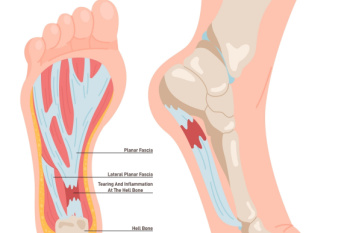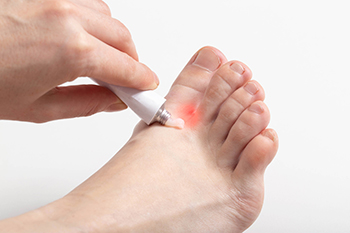Items filtered by date: November 2024
How Aging Affects Gait in Seniors

As people age, natural changes in gait can affect mobility and stability. Reduced calf muscle strength often leads to taking shorter steps, while balance issues may increase the period in the walking cycle when both feet are on the ground simultaneously. In younger adults, this phase typically makes up about 18 percent of the cycle, but it may increase to 26 percent or higher as people age or experience balance challenges. This added time on both feet offers greater stability, helping to lower fall risk. Joint changes, like reduced ankle flexibility, may further impact stride length. To maintain balance, older adults might shift their weight or adopt postural changes, leading to a wider stance and a less fluid movement. Neurological changes can make coordinating each step more difficult, slowing pace and reducing synchrony in body movement. A podiatrist can assess specific gait challenges in seniors and suggest exercises or custom orthotics to restore stability and improve gait mechanics. If you have trouble walking while carrying out daily activities, it is suggested that you make an appointment with a podiatrist for a gait analysis, exam, and treatment options.
Proper foot care is something many older adults forget to consider. If you have any concerns about your feet and ankles, contact Ankita Patel, DPM from All Pro Foot and Ankle. Our doctor can provide the care you need to keep you pain-free and on your feet.
The Elderly and Their Feet
As we age we start to notice many changes in our body, but the elder population may not notice them right away. Medical conditions may prevent the elderly to take notice of their foot health right away. Poor vision is a lead contributor to not taking action for the elderly.
Common Conditions
- Neuropathy – can reduce feeling in the feet and can hide many life-threatening medical conditions.
- Reduced flexibility – prevents the ability of proper toenail trimming, and foot cleaning. If left untreated, it may lead to further medical issues.
- Foot sores – amongst the older population can be serious before they are discovered. Some of the problematic conditions they may face are:
- Gouging toenails affecting nearby toe
- Shoes that don’t fit properly
- Pressure sores
- Loss of circulation in legs & feet
- Edema & swelling of feet and ankles
Susceptible Infections
Diabetes and poor circulation can cause general loss of sensitivity over the years, turning a simple cut into a serious issue.
If you have any questions please feel free to contact our office located in Swedesboro, NJ . We offer the newest diagnostic and treatment technologies for all your foot and ankle needs.
Pain Relief and Recovery Tips for Plantar Fasciitis

Plantar fasciitis is a common foot condition characterized by pain and inflammation in the plantar fascia, the thick band of tissue connecting the heel to the toes. This tissue supports the arch of the foot, but repetitive stress or strain can cause tiny tears, leading to irritation and discomfort. The hallmark symptom is sharp heel pain, especially noticeable with the first steps in the morning, or after periods of inactivity. People who are on their feet for long periods, have flat feet or high arches, or wear unsupportive footwear are more prone to developing plantar fasciitis. Treatment focuses on reducing inflammation and supporting the arch. Stretching exercises, custom orthotics, and anti-inflammatory medications are common approaches. Severe cases may benefit from targeted exercises, steroid injections, or, in rare instances, surgery. If you have heel pain, it is suggested that you visit a podiatrist for a proper diagnosis and treatment.
Plantar fasciitis can be very painful and inconvenient. If you are experiencing heel pain or symptoms of plantar fasciitis, contact Ankita Patel, DPM from All Pro Foot and Ankle. Our doctor can provide the care you need to keep you pain-free and on your feet.
What Is Plantar Fasciitis?
Plantar fasciitis is the inflammation of the thick band of tissue that runs along the bottom of your foot, known as the plantar fascia, and causes mild to severe heel pain.
What Causes Plantar Fasciitis?
- Excessive running
- Non-supportive shoes
- Overpronation
- Repeated stretching and tearing of the plantar fascia
How Can It Be Treated?
- Conservative measures – anti-inflammatories, ice packs, stretching exercises, physical therapy, orthotic devices
- Shockwave therapy – sound waves are sent to the affected area to facilitate healing and are usually used for chronic cases of plantar fasciitis
- Surgery – usually only used as a last resort when all else fails. The plantar fascia can be surgically detached from the heel
While very treatable, plantar fasciitis is definitely not something that should be ignored. Especially in severe cases, speaking to your doctor right away is highly recommended to avoid complications and severe heel pain. Your podiatrist can work with you to provide the appropriate treatment options tailored to your condition.
If you have any questions please feel free to contact our office located in Swedesboro, NJ . We offer the newest diagnostic and treatment technologies for all your foot and ankle needs.
Treating Foot Stress Fractures

Stress fractures are small cracks in the bones, often caused by repetitive force or overuse, and commonly seen in athletes and active individuals. Factors contributing to foot stress fractures include sudden increases in physical activity, wearing inadequate footwear, and underlying conditions like osteoporosis. Symptoms typically include localized pain in the midfoot area that worsens with activity, swelling, and tenderness when pressure is applied. Patients may also notice bruising or discomfort during weight-bearing activities. A podiatrist can accurately diagnose stress fractures through a physical exam, and imaging tests like X-rays or MRI scans. This type of doctor may recommend orthotic devices or modified activities to promote healing. In some cases, a short period of immobilization may be necessary. Recovery can vary, but generally takes several weeks, with a gradual return to activity once healing is confirmed. If you suspect a stress fracture, it is suggested that you schedule an appointment with a podiatrist for effective diagnosis and treatment.
Activities where too much pressure is put on the feet can cause stress fractures. To learn more, contact Ankita Patel, DPM from All Pro Foot and Ankle. Our doctor can provide the care you need to keep your pain free and on your feet.
Dealing with Stress Fractures of the Foot and Ankle
Stress fractures occur in the foot and ankle when muscles in these areas weaken from too much or too little use. The feet and ankles then lose support when walking or running from the impact of the ground. Since there is no protection, the bones receive the full impact of each step. Stress on the feet can cause cracks to form in the bones, thus creating stress fractures.
What Are Stress Fractures?
Stress fractures occur frequently in individuals whose daily activities cause great impact on the feet and ankles. Stress factors are most common among:
- Runners
- People affected with Osteoporosis
- Tennis or basketball players
- Gymnasts
- High impact workouts
Symptoms
Pain from the fractures occur in the area of the fractures and can be constant or intermittent. It will often cause sharp or dull pain with swelling and tenderness. Engaging in any kind of activity which involves high impact will aggravate pain.
If you have any questions please feel free to contact our office located in Swedesboro, NJ . We offer the newest diagnostic and treatment technologies for all your foot and ankle needs.
Athlete’s Foot Is a Common Fungal Infection

Athlete's foot, also known as tinea pedis, is a fungal infection that affects the skin on the feet, often starting between the toes. It thrives in warm, moist environments like locker rooms, public showers, and sweaty shoes. Causes include walking barefoot in these type of areas or wearing damp footwear for extended periods of time. Symptoms of athlete’s foot consist of itching, redness, peeling, and cracking skin, typically between the toes, and sometimes blisters or sores. In severe cases, the infection can spread to the toenails or other parts of the body. Diagnosis is usually made based on the appearance of the skin, but a podiatrist may take a skin scraping to confirm the presence of fungus. In persistent cases of athlete’s foot, prescription-strength antifungals may be needed. If you have athlete’s foot that is not clearing up, it is suggested that you schedule an appointment with a podiatrist for treatment.
Athlete’s foot is an inconvenient condition that can be easily reduced with the proper treatment. If you have any concerns about your feet and ankles, contact Ankita Patel, DPM from All Pro Foot and Ankle. Our doctor will treat your foot and ankle needs.
Athlete’s Foot: The Sole Story
Athlete's foot, also known as tinea pedis, can be an extremely contagious foot infection. It is commonly contracted in public changing areas and bathrooms, dormitory style living quarters, around locker rooms and public swimming pools, or anywhere your feet often come into contact with other people.
Solutions to Combat Athlete’s Foot
- Hydrate your feet by using lotion
- Exfoliate
- Buff off nails
- Use of anti-fungal products
- Examine your feet and visit your doctor if any suspicious blisters or cuts develop
Athlete’s foot can cause many irritating symptoms such as dry and flaking skin, itching, and redness. Some more severe symptoms can include bleeding and cracked skin, intense itching and burning, and even pain when walking. In the worst cases, Athlete’s foot can cause blistering as well. Speak to your podiatrist for a better understanding of the different causes of Athlete’s foot, as well as help in determining which treatment options are best for you.
If you have any questions please feel free to contact our office located in Swedesboro, NJ . We offer the newest diagnostic and treatment technologies for all your foot and ankle needs.
